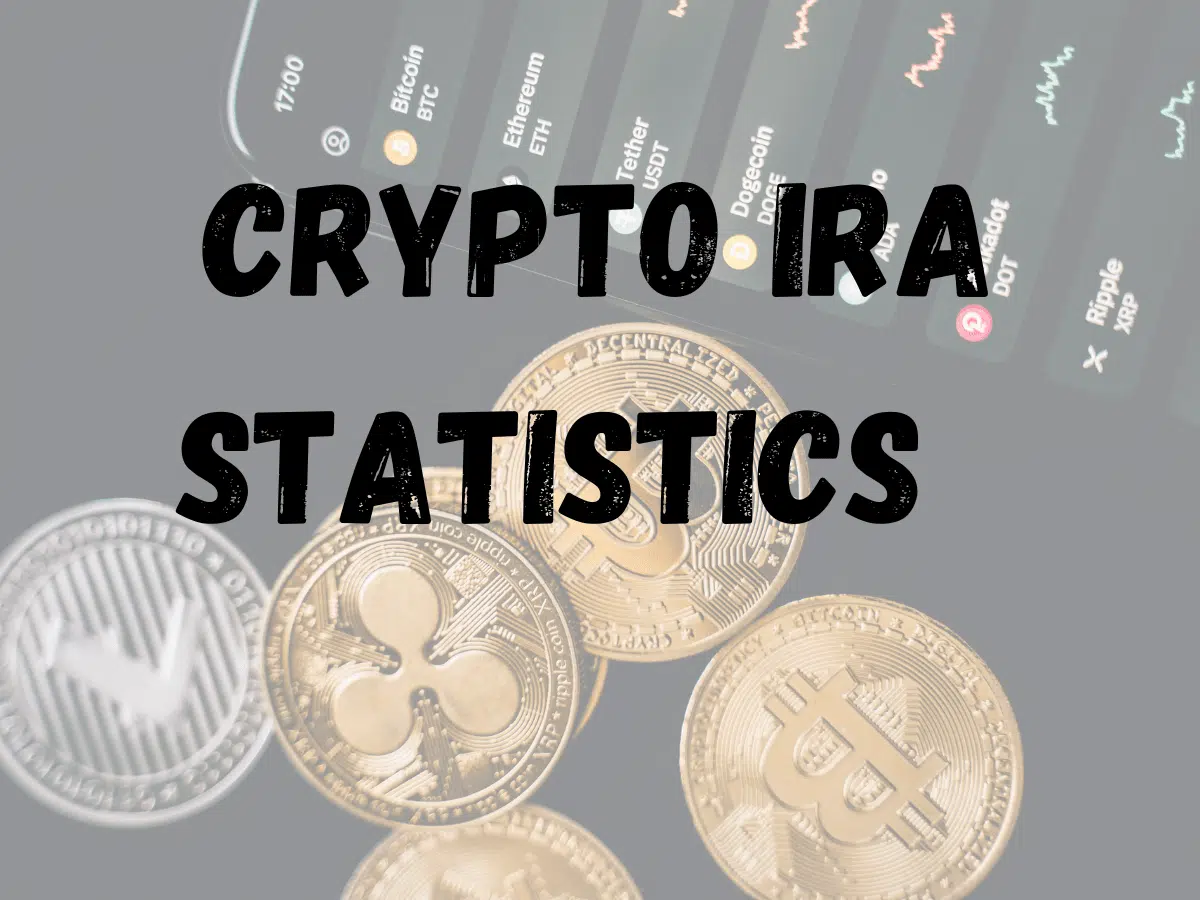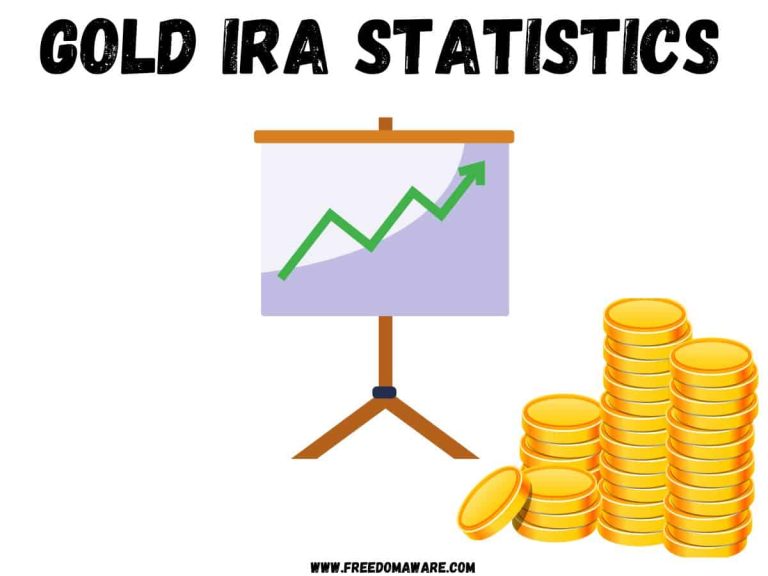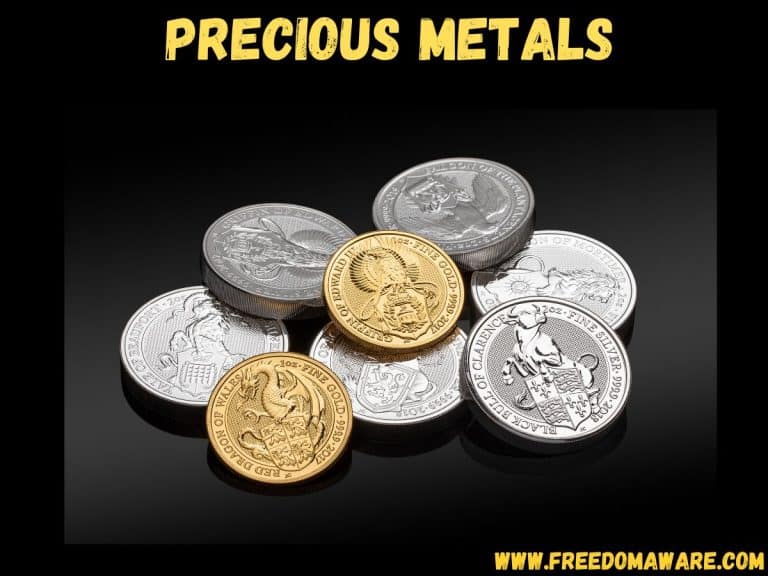47+ Crypto IRA Statistics To Know in 2024

The introduction of cryptocurrencies and digital assets has helped to facilitate the growth of the world's financial market. Nowadays, individuals interested in finance are looking into these cryptocurrencies and digital assets as they have proven to provide great returns and have served as a means of earning passive income. Here are some crypto IRA statistics.
The creation of the pioneer cryptocurrency, Bitcoin (BTC), introduced the concept of decentralization, thereby eliminating the factor of middlemen and third-party entities associated with centralized bodies, including but not limited to banks and lending institutions. After Bitcoin (BTC) was created, other cryptocurrencies known as altcoins gradually made their way into the financial world, creating what is now known as the cryptocurrency market.
These altcoins, such as Ethereum (ETH), Decentralized (MANA), and Tron (TRX), have provided crypto users with amazing and profitable features and benefits. Other variants of these cryptocurrencies and digital assets in the form of meme coins and NFTs also possess growth and profit potential for users of the crypto market. Investors are now looking to save their retirement funds in these cryptocurrencies long-term as they have evidently proven to be great sources of investments.
This article contains information about cryptocurrencies, how they benefit users who invest in them via crypto IRAs, and the statistics associated with a crypto IRA used as a case study.
1. Cryptocurrency has experienced significant growth over the last decade, evolving from an obscure asset to a popular investment.
2. Cryptocurrencies are digital currencies secured through cryptography and decentralized computer networks, not overseen by traditional institutions.
3. Transactions in cryptocurrencies maintain semi-anonymity for buyers and sellers.
4. Blockchain technology, an electronic ledger, enables anonymous digital transactions for cryptocurrencies.
5. Bitcoin, the first cryptocurrency, was launched in 2009, and its first transaction involved the purchase of two Papa John’s pizzas.
6. Over 21,000 different cryptocurrencies have emerged since Bitcoin's inception, with Ethereum and Tether following Bitcoin in value.
7. A July 2023 survey revealed that 26% of millennials in the U.S. owned Bitcoin, compared to 14% of all adults.
8. Global mining for major cryptocurrencies contributes to estimated carbon dioxide emissions of 110 – 170 million metric tons per year.
9. Cryptocurrencies can be categorized into types: Equity tokens, Utility tokens, Intrinsic tokens, and Asset-backed tokens.
10. Equity tokens represent ownership in an underlying asset, similar to traditional stocks, recorded on the blockchain.
11. Utility tokens raise funds for new cryptocurrency projects and serve specific purposes for developers.
12. Intrinsic tokens, like Bitcoin and Ethereum, exist as digital currency without representing anything else.
13. Asset-backed tokens are digital IOUs backed by physical assets like gold or art.
14. Following the 2008 recession, Satoshi Nakamoto introduced a white paper addressing central bank control, leading to the creation of Bitcoin in 2009.
15. Bitcoin aimed to eliminate control, oversight, and fees associated with cash transactions, relying on cryptographic networks.
16. The first blockchain, with the genesis block, was launched on Jan. 3, 2009.
17. Bitcoin's first real transaction occurred on May 22, 2010, involving the purchase of two pizzas for 10,000 bitcoins.
18. In February 2011, Bitcoin's price surpassed $1, and by November 2021, it reached an all-time high of $68,789.
19. Over 21,000 cryptocurrencies have been created since Bitcoin's inception, with Bitcoin, Ethereum, and Tether leading in value.
20. The total value of all cryptocurrencies is approximately $1.05 trillion, with Bitcoin accounting for around $508 billion.
21. Global payments revenue is expected to exceed $3 trillion by 2026.
22. As of Aug. 27, 2023, the size of the Bitcoin blockchain is approximately 507 gigabytes.
23. About 21% of American adults owned cryptocurrency as of 2022.
24. Vietnam tops Chainalysis's global crypto adoption index, followed by the Philippines and Ukraine.
25. High adopters of cryptocurrency include developing markets like Ukraine, Kenya, and Nigeria.
26. In the U.S., high-income earners comprise 25% of crypto owners compared to 15% of the general public.
27. About 70% of cryptocurrency owners are men, representing 48% of the general population.
28. U.S. crypto ownership by ethnicity in 2021: White (62%), Hispanic (24%), Black or African American (8%), Asian (6%).
29. Crypto ownership by generation in the U.S. in 2021: Gen Z (13%), Millennials (57%), Gen X (20%), Baby Boomers (10%).
30. Cryptocurrency mining's environmental impact is a topic of concern due to the high energy consumption.
31. Bitcoin and other cryptocurrencies are mined on decentralized computer networks using blockchain technology.
32. Bitcoin's estimated annualized electricity consumption is 136 terawatt-hours as of August 2023.
33. Bitcoin mining accounts for 0.61% of the world's electricity consumption.
34. Bitcoin mining creates approximately 68.8 million metric tons of carbon dioxide emissions per year.
35. If Bitcoin were a country, it would be among the top 40 energy users globally.
36. One Bitcoin transaction's carbon footprint is equivalent to over 762,000 Visa transactions.
37. Bitcoin emissions alone could contribute to an increase in the global temperature above 2°C.
38. Bitcoin mining consumes the same amount of electricity as all the world's data centers.
39. Cryptocurrencies' initial anonymity posed challenges for government tax agencies, leading the IRS to treat them as property in 2014.
40. The IRS reportedly loses an estimated $50 billion annually in taxes on cryptocurrency assets.
41. Buying and holding cryptocurrency is not a taxable event, but selling requires reporting profit or loss on tax returns.
42. Cryptocurrency's popularity has grown, but its volatility and the impact of rising interest rates led to selloffs in 2022.
43. Major cryptocurrencies like Bitcoin face challenges as both trading vehicles for profit and functional currencies.
44. Governments, including the U.S., are exploring regulations for cryptocurrencies to assess risks to financial stability.
45. U.S. President Joe Biden signed an executive order on March 9, 2022, calling for a review of digital assets, including cryptocurrencies.
46. Ten countries, including Algeria, Bolivia, and Saudi Arabia, have banned cryptocurrency, citing difficulties in tax reporting and controversies.
47. El Salvador and the Central African Republic accept crypto as legal tender, but implementation challenges have been noted.
48. While some companies worldwide accept cryptocurrency, its official adoption as a widely available currency is still limited.
49. AT&T, Microsoft, Overstock.com, Twitch, AMC theaters, and the Dallas Mavericks are among companies accepting cryptocurrency as payment.
50. Despite initial acceptance, some companies rescind cryptocurrency payment options due to low customer usage.
These points cover key aspects of cryptocurrency, its history, types, market trends, environmental impact, demographics, taxes, and its potential as a future form of money.
What is a Crypto IRA?
An Individual Retirement Account, commonly referred to as an IRA, is a savings account that individuals who receive earned income can utilize to save for long-term purposes. Individuals who make use of IRAs enjoy unique tax advantages. Typically, an IRA is designed mainly for self-employed individuals with no access to special workplace retirement accounts, which are available only through employers such as a 401(k).
A Crypto IRA is a unique IRA that only includes cryptocurrencies assets, and digital currencies in its portfolio. Although the Internal Revenue Service (IRS) does not recognize any IRA specific for cryptocurrencies, in 2014, the IRS taxed cryptocurrencies as property. In the case of Federal tax, cryptocurrencies and crypto assets are treated as property. However, in terms of retirement investments, they are allocated the same tax breaks as regular investments.
This means that these cryptocurrencies are taxed in the same manner as bonds, stocks, or other types of investment properties. Like other investments, these properties cannot be placed into an IRA by the holder of the account.
Factors to Consider When Choosing a Crypto IRA
To determine which crypto IRA is the best to invest in, there are several factors that need to be considered. These factors include:
● Considering means of Funding the IRA: It is important for investors to determine the means by which their new crypto IRA will be funded. Funding can be through an annual contribution, rolling over funds from one retirement account, or transferring funds from an already existing IRA.
● Determining Cryptocurrency to Purchase: Investors need to research which type of cryptocurrency they consider purchasing. Bitcoin is a common purchase option for most IRA investors; however, there are other eligible and potentially profitable cryptos on the market that are also worth purchasing.
● Choosing which IRA to invest in Performing research on which crypto IRA custodian to open an account with and comparing relevant fees and commissions should be of utmost priority to investors.
How does Crypto IRAs Work?
Although crypto IRAs have higher risks associated with them, just like traditional IRAs and other investment options such as bonds, stocks, and mutual funds, crypto IRAs possess the potential to provide high returns for their investors. They also follow the same rules as traditional IRAs, and this means that people who invest in them will be responsible for early withdrawal fees if they decide to cash out before the designated age of retirement, which is 59½ years.
One major question on the lips of investors looking into crypto IRAs is, how do they work?
Crypto IRAs have the same operating mechanism as regular IRAs. There are two types of IRAs that investors looking to save their retirement funds in crypto can utilize:
1. Self-Directed IRAs (SDIRAs): This type of IRA allows people to invest in various alternative asset classes that are usually not available for regular or traditional IRA holders. Cryptocurrencies, such as Bitcoin (BTC), are one of such asset classes as it is available for investors to diversify their retirement portfolio. Investors looking to include cryptocurrencies in their IRA portfolio need to enlist the help of a custodian, such as Self-Directed IRAs (SDIRAs).
Since it is self-directed, investors take full responsibility for their investment choices. The SDIRAs only serve as custodians as they do not give any financial advice or conduct extensive due diligence on behalf of the investors.
2. Crypto-Specific IRAs: These IRAs are only specific for the investment of cryptocurrencies and crypto assets. These IRAs allow investors to choose from a list of providers who can act as custodians for the funds in their crypto wallet.
What are the Advantages of Crypto IRAs?
There are several advantages associated with Crypto IRAs. These include:
● Increased Growth Potential: Investors who add cryptocurrencies to their IRAs are more likely to experience an increase in the growth potential of their portfolios. There is also likely to be an increase in the future accessibility of the portfolio. Since they are ideal for long-term investments, Crypto IRAs are a great medium for investments with significant growth potential over decades.
● Diversified Portfolios: One major benefit of acquiring crypto IRAs is the diversification it adds to retirement portfolios. This may prevent the investor's retirement account from experiencing any of the problems associated with major market downturns or other tumultuous activities that affect physical assets in the future.
● Tax Strategies: For individuals who are interested in investing in cryptocurrencies and at the same time avoid hefty taxes in capital gains, utilizing a retirement account that includes digital currencies may just be the best bet. Putting cryptocurrencies in a Roth IRA allows investors to make capital gains without being taxed since taxes have already been paid on the funds in the retirement account. On the other hand, investors who place their income in a regular IRA will pay income taxes when they withdraw from the account.
● Facilitated Peer-to-Peer (P2P) Transactions: One major distinguishing factor that places cryptocurrency investment above all other investments on the financial market is the absence of middlemen or third-party entities facilitating a transaction. This aids in helping the parties involved to get a clearer understanding of the terms associated with the transaction. It also helps to create a situation where both parties are accountable to each other.
What are the Disadvantages of Crypto IRAs?
● Price Volatility of Crypto Assets: It is a well-known fact that the prices of most cryptocurrencies and crypto assets on the market today are very volatile. An example can be seen in the popular cryptocurrency, Bitcoin (BTC). Since its inception, the price of Bitcoin (BTC) has gone from 0 to $60,000 and then back to one-third of that price. This volatility in price makes Crypto IRAs a tough sell as a potential retirement investment. Individuals who are approaching retirement require the security of stable and liquid assets such as bonds and stocks.
● High Cost of Trading Fees: The fees associated with crypto trading and crypto IRAs are very high. For instance, an individual looking to set up a $50,000 self-directed IRA (SDIRA) for trading might spend several thousand dollars in trading fees and charges to the IRA provider during the investment process. These fees range from initial set-up fees to trading and custody fees and even up to annual maintenance fees. Recurring custody and maintenance fees are also charged by these IRA providers.
● Increased Risk of Losses: The volatility of the price of cryptocurrencies increases the risk of losses through a large decline in value. In a scenario where an individual purchases a cryptocurrency for $5,000 whose price declined to more than 75% of its value, in such a case, the individual has lost $3,750. Large investments would lead to a large increase in the losses. Another factor that could contribute to the increased risk of losses is the fact that many cryptocurrencies are not backed by other businesses or assets. This might make the cryptocurrencies lose the interest of the public and their investors after they have been purchased or included in a crypto IRA.
● Poor Scalability: Due to the decentralized nature of the crypto platform, it can be quite difficult for crypto IRA investors to imagine a time when cryptocurrencies and crypto assets can compete with other established forms of investments.
Crypto IRA Statistics
There are numerous crypto IRA companies on the market today, including but not limited to Bitcoin IRA, BitIRA, iTrust Capital, and Equity Trust. In this section, the iTrustCapital crypto IRA software platform will be utilized as a case study.

What is iTrustCapital?
With its headquarters in Irvine, California, iTrustCapital is the #1 crypto IRA platform in the United States of America. It is a software platform that was created for the sole purpose of disrupting the self-directed IRA (SDIRA) industry by providing its clients with certain tax advantages when they buy and sell cryptocurrencies assets.
SUPPORT:
TEAM:
SECURITY:
PRODUCTS:
PRICING:
Created in 2018, iTrustCapital aims to utilize its revolutionary software to eliminate the problems that plague previous IRA models, such as outdated working mechanisms and costly inefficiencies. This will assist in opening the door for clients to gain unrestricted access and trading rights to various cryptocurrencies and digital assets via their IRAs.
iTrustCapital was voted the Innovator of the Year in 2021. It also won the award for the Best Crypto Investment Platform by the IMA Impact21 Awards. Although based in California, the iTrustCapital platform is available to credible and qualified investors based in most states in the United States of America. The platform also provides easy access to up to 29 cryptocurrencies as well as physical assets such as gold and silver. iTrustCapital ensures that new digital assets are continually added to meet the demands of its clients.
iTrustCapital Statistics
- In connection with its numerous vendors and partners, iTrustCapital has garnered over $2 billion in assets and possesses over 40,999 client-funded accounts since its inception. The company, which started with a value of $2 billion, grew to $6 billion in total transaction volume from 2021 to 2022. This has helped it to receive up to 2,200 glowing reviews and an average rating of 4.4 stars from Trustpilot.
- With its aim of offering fees at a subsidized rate compared to that of its competitors while focusing on creating scalable technology and a commitment to delivering an excellent client experience, iTrustCapital has the potential to transform the SDIRA market by unleashing up to $13 million worth of U.S. retirement funds into crypto assets.
- Focused on incorporating the new crypto-related features, the iTrustCapital company intends to include crypto staking services to its platform. It also aims to allow the crypto users to okay governance roles through the use of governance tokens of the following platforms; MakerDAO (MKR), Uniswap (UNI), Polkadot (DOT), Sushi (SUSHI), Compound (COMP), and so on.
- The iTrustCapital platform provides its investors with optimal insurance coverage for deposits of $320 million. This is in accordance with an agreement with Coinbase custody.
- To lower the barrier to entry into the self-directed IRA (SDIRA) industry, several improvements are being made to the product offerings associated with the iTrustCapital platform. These improvements will also help decree the contribution needed to open an account from $2,500 to a cheaper amount of $1,000. Monthly service fees will also be eliminated. It is worth noting that in August 2022, iTrustCapital recorded its highest average initial funding.
- In 2022, iTrustCapital experienced a significant increase in the number of newly funded client accounts opened. There was also an upward momentum in the platform's total transaction volume, which has evidently manifested in the increased transaction activity and usage of the software platform. During this period, there was a 61% increase in the number of newly funded accounts, as 15,000 accounts were added to the initial 25,000 accounts, making a total of 40,000 accounts on the platform. Users were allowed to establish more than one IRA, including a Roth IRA, SEP IRA, or a traditional IRA on the iTrustCapital software platform.
- The iTrustCapital platform has raised more than $125 million in Series A funding. According to a press release by CoinDesk, this amount was raised with a post-money valuation price of more than $1.3 billion. The growth equity firm known as Left Lane Capital led this round of increase in the platform's valuation price.
As part of the investment agreement, Matthew Miller, who is the Principal of Left Lane, will join the iTrustCapital platform board of directors. The revenue generated will assist iTrustCapital in expanding its services and products, improve the scalability of development teams and client services, aid the exploration of potential strategic acquisitions, and facilitate the launch of new marketing channels.
- There is a standard commission of 1% charged on the iTrustCapital platform. This commission will only be 1% for investors purchasing or selling cryptocurrencies. The cost of transaction for Gold and Silver is based on the current market price of these precious metals. Gold has a transaction commission of $50 over spot per ounce, while Silver, on the other hand, has a transaction commission of $2.50 over spot per ounce.
- Todd Southwick, CEO of iTrustCapital, told CoinDesk in an interview that iTrustCapital intends to add more than 200,000 accounts to its platform in the next few years.
- Users of the iTrustCapital platform are allowed to transfer their cryptocurrencies from other platforms without having to sell them. However, there will be a one-time conversion charge of $75 for users who wish to convert their traditional IRA into a Roth IRA or a SEP IRA.
Conclusion
When considering adding cryptos to their retirement plans through crypto IRAs, investors need to ensure that the crypto IRA custodians working with their retirement accounts are prepared to take on extra reporting duties with the IRS. This is important to prevent the IRA from running into problems with the IRS. However, this could translate to even more fees being charged to IRA investors.
There are numerous fraudulent companies offering investment services to investors in the financial market. It is, therefore, important for investors to be careful when looking for custodians to execute their crypto investment wishes. Institutions like the Securities and Exchange Commission (SEC) and the United States Commodities Futures Commission (CFTC) have issued several alerts about fraudulent crypto IRAs. According to the CFTC, these IRAs claim that they are approved by the IRS in order to lure investors into their scams.
Although cryptocurrencies and digital assets are great sources of revenue, it is necessary for crypto users interested in purchasing them to conduct proper research, as the volatility of these cryptocurrencies and digital assets can pose certain risks to the investment portfolios of their buyers.






